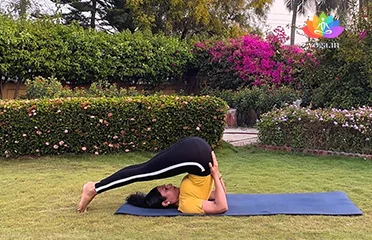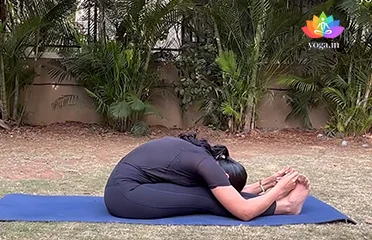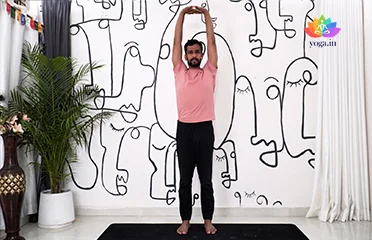Halasana (Plough Pose)
हलासन / Plough Pose
The Sanskrit name is derived from Hala (हला) meaning plough and asana [�K]
Paschimottanasana (Seated Forward Bend)
पश्चिमोत्तानासन / Seated Forward Bend
The Sanskrit name is derived from three sanskrit words: Paschima (पश्चिमा) [�K]
Tadasana (Mountain Pose)
ताड़ासन / Mountain Pose
The sanskrit name is derived from tada (ताड़ा) meaning mountain and [�K]
How Yoga Can Help Cure Epilepsy
Epilepsy is a neurological disorder characterized by recurrent seizures. Yoga serves as a holistic approach to complement traditional medical treatments. Through a combination of physical postures, breathing exercises, and meditation, yoga can contribute to managing epilepsy symptoms by promoting relaxation, reducing stress, and enhancing overall well-being.
Understanding Epilepsy:
Epilepsy is a neurological condition characterized by abnormal brain activity, leading to seizures or periods of unusual behavior, sensations, and sometimes loss of awareness. It can manifest in various forms, such as generalized seizures, focal seizures, or absence seizures, affecting individuals differently based on the type and severity of their condition.
Yoga’s Role in Relieving Epilepsy:
Specific yoga practices, including gentle asanas (poses) and pranayama (breathing exercises), can help alleviate epilepsy symptoms. Asanas such as Savasana (Corpse Pose), Viparita Karani (Legs-Up-the-Wall Pose), and Sukhasana (Easy Pose) promote relaxation and reduce stress levels. Pranayama techniques like Nadi Shodhana (Alternate Nostril Breathing) and Kapalabhati (Skull-Shining Breath) can calm the mind and enhance overall well-being.
Key Factors Contributing to Epilepsy:
Understanding the factors contributing to epilepsy is crucial for effective management:
- Genetic Predisposition: Family history of epilepsy can increase susceptibility.
- Brain Abnormalities: Structural or developmental abnormalities in the brain.
- Head Trauma: Traumatic brain injuries can trigger seizures.
- Infections: Certain infections like meningitis or encephalitis can lead to epilepsy.
- Stroke or Vascular Diseases: Conditions affecting blood flow to the brain can increase the risk.
- Developmental Disorders: Conditions like autism or neurofibromatosis can be associated with epilepsy.
Symptoms of Epilepsy:
Common symptoms associated with epilepsy include:
- Seizures: Convulsions, loss of consciousness, and involuntary movements.
- Temporary Confusion: Disorientation or memory lapses after a seizure.
- Aura: Sensations like tingling or smelling unusual odors before a seizure.
- Loss of Awareness: Brief episodes of staring blankly into space.
- Uncontrollable Movements: Jerking movements of the arms and legs.
- Strange Sensations: Feelings of déjà vu or fear without an apparent cause.
Treatment of Epilepsy through Yoga and Pranayama:
Yoga and pranayama can complement traditional epilepsy treatments. Some beneficial practices include:
Specific Yoga Poses:
- Supta Baddha Konasana (Reclining Bound Angle Pose): Promotes relaxation and eases tension.
- Matsyasana (Fish Pose): Stimulates the nervous system and enhances circulation.
- Balasana (Child’s Pose): Calms the mind and relieves stress.
Pranayama Exercises:
- Sheetali Pranayama (Cooling Breath): Reduces stress and induces relaxation.
- Bhramari Pranayama (Bee Breath): Soothes the nervous system and promotes mental clarity.
Diet for Epilepsy:
A balanced diet can support epilepsy management. Considerations include:
- Low-Glycemic Foods: Foods that release glucose slowly can help stabilize blood sugar levels.
- Healthy Fats: Omega-3 fatty acids from sources like fish, flaxseeds, and chia seeds.
- Nutrient-Rich Foods: Fruits, vegetables, and whole grains provide essential vitamins and minerals.
- Hydration: Proper hydration is essential; aim to drink plenty of water throughout the day.
Caution for Epilepsy:
Practicing yoga for epilepsy requires caution:
- Avoid Overexertion: Listen to your body and avoid pushing yourself beyond your limits.
- Supervision: If prone to seizures, practice yoga under the guidance of a qualified instructor or healthcare provider.
- Medication Adherence: Maintain consistent medication schedules as prescribed by your doctor.
Contraindications for Epilepsy:
Certain yoga practices may not be suitable for individuals with epilepsy:
- Inversions: Poses that involve going upside down may increase the risk of seizures.
- Breath Retention: Practices involving breath retention can alter blood flow and trigger seizures.
- Hot Yoga: Intense heat can exacerbate symptoms and should be avoided.




